|
|

|
|
Author
|
Topic: NASA's Improved Shuttle External Tank Begins Journey to Launch
|
Robert Pearlman
Editor Posts: 42988
From: Houston, TX
Registered: Nov 1999
|
 posted 12-31-2004 03:18 PM
posted 12-31-2004 03:18 PM
   
NASA Release (Photo credit: collectSPACE.com) 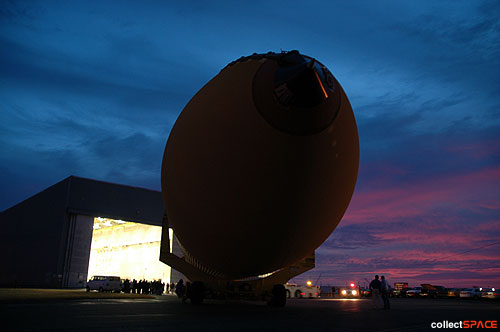 NASA's Improved Shuttle External Tank Begins Journey to LaunchThe huge, orange External Tank (ET) that will help launch Space Shuttle Discovery on its next mission isn't glitzy like the crystal New Year's ball in Times Square. But its journey from NASA's Michoud Assembly Facility marks something special for 2005: the Year of Return to Flight.
The tank, designated ET-120, rolled out on its transporter and was loaded onto a covered barge today at Michoud, in New Orleans, for shipment to NASA's Kennedy Space Center, Fla. The barge will take four to five days to travel from the Mississippi River-Gulf of Mexico Outlet to Florida's Banana River, which flows into the Atlantic Ocean. Shipping the tank is an important milestone, particularly for the NASA team that spent 23 months working on modifications to make it safer. "Our team of contractors and civil servants has worked hard developing, testing and implementing improvements that will reduce the risk to the orbiter during liftoff and ascent," said Sandy Coleman, manager of the External Tank Project, an element of the Space Shuttle Propulsion Office at NASA's Marshall Space Flight Center in Huntsville, Ala. "This will be the safest, most reliable tank NASA has ever produced." During a launch, the ET delivers 535,000 gallons of liquid hydrogen and oxygen propellants to the three main engines, which power the Shuttle to orbit. It is covered by polyurethane-like foam, with an average thickness of about one inch. The foam insulates the propellants, keeps ice from forming on the tank's exterior, and protects its aluminum skin from aerodynamic heat during flight. Modifications to the tank address the Columbia Accident Investigation Board's recommendation to reduce the risk to the Shuttlring Columbia's launch in January 2003, insulating foam from the bipod area, near the front of the craft where the ET attaches to the orbiter, fell off the and damaged the left wing. ET-120 incorporates several safety improvements, including an improved bipod fitting that connects it to the orbiter; a video camera mounted on the liquid oxygen feed line to document liftoff; reversed bolts on the flange of the tank's mid-section and a new spraying procedure for the thermal protection required there; a redesign of three bellows on the liquid oxygen feed line, the 70-foot pipe feeding liquid oxygen to the main engine; and a more defined spray procedure on the longeron, a structural support for the tank's aft, orbiter attachment struts. "Clearly, the modifications to the External Tank are at the heart of our Return to Flight work," said Michael Kostelnik, deputy associate administrator for the International Space Station and Space Shuttle Programs. "Seeing this tank begin its journey to the Kennedy Space Center, where it will be prepared for launch, makes it clear how far we've come in making the Shuttle a safer spacecraft for our astronauts," he said. The ET is the largest element of the Shuttle system, which also includes the orbiter, main engines and Solid Rocket Boosters. It measures 27.6 feet wide and 154 feet tall. Despite the tank's size, the aluminum skin covering it is only one-eighth-inch thick in most areas. Yet, it still withstands more than 6.5 million pounds of thrust during liftoff and ascent. The tank is the only Shuttle component that cannot be reused.
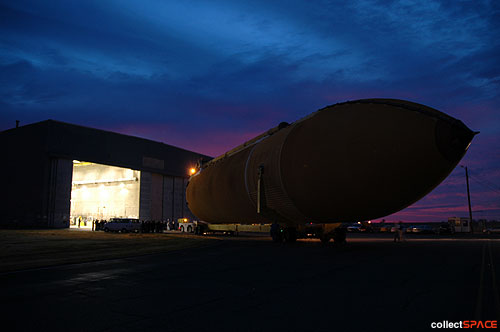 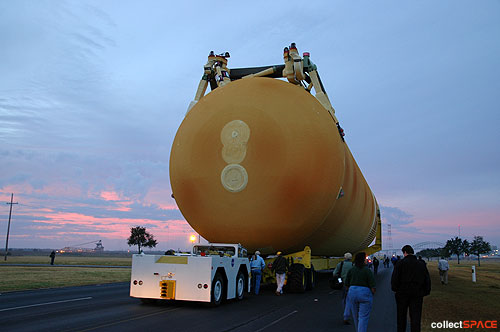
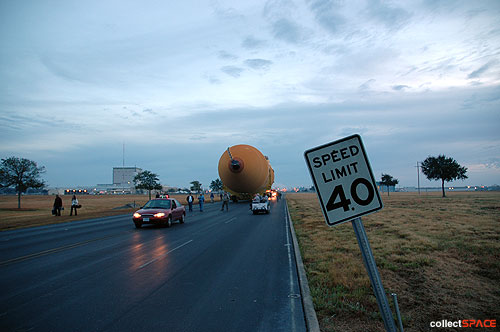
|
Robert Pearlman
Editor Posts: 42988
From: Houston, TX
Registered: Nov 1999
|
 posted 12-31-2004 03:21 PM
posted 12-31-2004 03:21 PM
   
More photographs from today...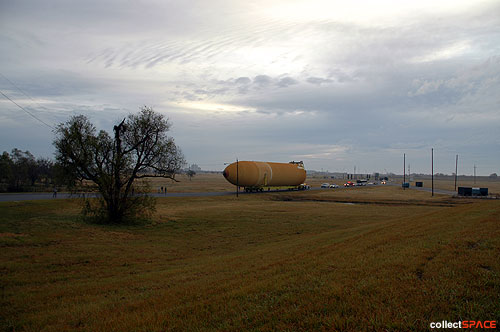 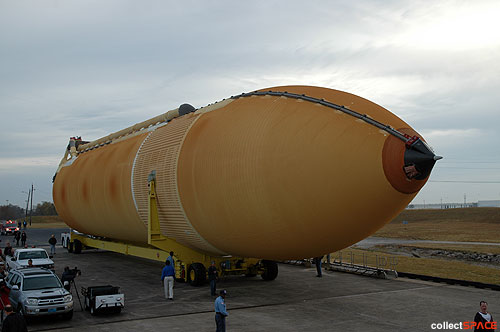
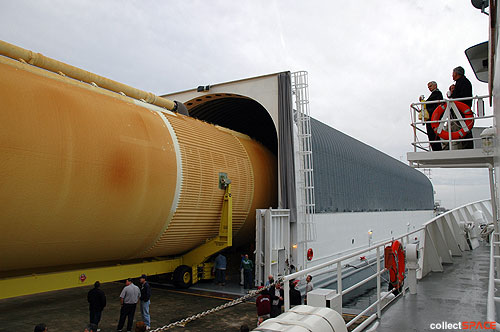
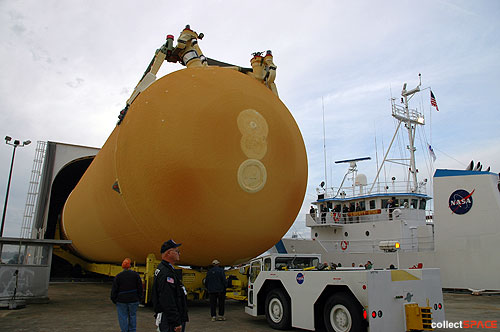
|
nojnj
Member Posts: 503
From: Highland Heights, KY
Registered: Feb 2003
|
 posted 12-31-2004 03:32 PM
posted 12-31-2004 03:32 PM
   
That was a great report and photos! I really appreciate you and others' reports and photos at events I have no chance of observing. Thanks! |
fabfivefreddy
Member Posts: 1067
From: Leawood, Kansas USA
Registered: Oct 2003
|
 posted 12-31-2004 05:27 PM
posted 12-31-2004 05:27 PM
   
Very cool! Thanks! |
NASAVideographer
New Member Posts:
From:
Registered:
|
 posted 01-02-2005 12:47 AM
posted 01-02-2005 12:47 AM
   
Robert, was that you who I almost hit with my video camera as I quickly panned left while shooting the ET from the tow boat? If so, sorry about that... I didn't see you on my left.It was amazing seeing the ET roll down that road... I felt honored to be so close. I will be editing a video file of the event that will air on NASA Select around noon Monday... with selected video and interviews. |
Robert Pearlman
Editor Posts: 42988
From: Houston, TX
Registered: Nov 1999
|
 posted 01-02-2005 01:24 AM
posted 01-02-2005 01:24 AM
   
Yes, that was me ...but no harm done. I was probably just as much alert to my own surroundings, as the External Tank was such a sight to behold. At one point during its mile-long rollout, I put aside my camera and just walked alongside it (within an arm's length) and just marveled at its size. I've see it vertical in the VAB and on the pad, but neither do it as much justice (especially hidden behind the orbiter) as witnessing it horizontal and inches away. I look forward to watching your video of the ET's departure... as well as seeing if perhaps I can spot myself.  |
pokey
Member Posts: 361
From: Houston, TX, USA
Registered: Aug 2000
|
 posted 01-31-2005 03:18 PM
posted 01-31-2005 03:18 PM
   
Here is Wayne Hale's email to the worker bees. I don't usually send this stuff out, but it seems to have gone to many others besides just my group and is in the spirit of this year's return to flight and on the heels of last week's Day of Remembrance (with tomorrow being the dreaded February 1st): From: HALE, N. W., JR (WAYNE)
Subject: MotivationDuring the last days of 2004, there was an electric atmosphere at the Michoud Assembly Facility as the ET-120 for STS-114 came to completion. Everyone there could see the work was wrapping up and the opportunity to ship out a finished tank by the end of the year was tantalizing. No management incentive or motivational technique could possibly have been as powerful as the as the vision of rolling that tank out of the factory and the pride that comes from a hard job well done. In those days the workforce at MAF had a spring in their step and a grin on their face and a quickened tempo to get the work done. During the very the same days, exactly the same sense of accomplishment and excitement was filling the air at the McDonald Detweiler Robotics plant in suburban Toronto as the OBSS - that new invention to allow complete inspection of the orbiter - was finished and left snowy Canada for the warmer climate of Florida and its date with history. Now, infectious optimism is rampant at the Kennedy Space Center. In OPF3, Discovery is visibly close to rolling out to the VAB and the workers on the floor can smell the heady aroma of success and completion of their work. Over in OPF1, the techs working on Atlantis have the same pride as their ship daily makes visible progress to be ready for its potential (and hopefully never used) role as a rescue craft. The SRBs are stacked, gleaming and ready on the mobile launch platform and the tank - the one that the folks in Louisiana are so very proud of - will be bolted with them in a matter of days. The real stress in the system lies with the engineers and analysts who are striving heroically to complete all the paperwork necessary to prove the system is safe to fly. Alone in the program, these folks are the only ones where the end is not in sight. Long sleepless hours and weekends at the desk will be their life for the next three months or more. It will be a hard slog for them to dig out from under all that work over the next several weeks. But even among the engineering workforce, like crocus poking up through the snow, there are signs of hope that spring will come and optimism is possible. In the midst of this sea of buoyant optimism, the calendar has rolled around to the certain red-rimmed dates: January 27th, January 28th, February 1st. Apollo 1, Challenger, Columbia. We must ensure that even the newest employee in our halls knows the history of those days. Most importantly, we must remember that none of those terrible events was inevitable. There is no reason that these days should not be ordinary dates. Human failing in every case mixed with multiple missed opportunities caused catastrophe. We can never again be complacent, lax, or persuaded that our business is ordinary and therefore requires only ordinary attention to detail. There must never be an Atlantis tragedy or a Discovery accident or an Endeavour disaster. Almost forty years ago, Gus Grissom told the spacecraft assemblers at Downey "Do good work." Echoing down four decades of history, Gus Grissom's words inescapably speak to us: "Do good work." The plain message of this ultimately concise sentence is unavoidable; it leaves no room for misunderstanding, no place for lawyerly quibbling over the meaning of its words, no chance to plead ignorance. Prominently displayed at Downey in the Apollo days was a sign that proclaimed "Waste anything but time". In their rush to win the race, our predecessors failed to heed Gus's words and he and his crew paid the price with their lives. No matter what we are doing in this business, we must do it right, we must do it with a strict attention to detail. This is no ordinary business; the margin between success and failure - on the best day - is thin, the energies involved are too great, the materials are exotic, the environments are extreme. No room for anything other than good work. In the final hours before ET-120 rolled out of Michoud, a huge team inspected every square inch of the foam on the outside of that tank, often using magnifying lenses. The tank is bigger than a grain silo, 154 feet tall by 27 feet in diameter; but it was examined under a microscope. That attention to detail is what is our business requires. Every smudge on that foam was examined in detail and evaluated against strict criteria based on rigorous engineering analysis. With the factory door ready to be opened, a quality inspector, almost in tears, pointed out a miniscule flaw that somehow crept into the foam in a critical area. It would take hours to cure the glue required in the repair. A technical meeting ensued with evidence indicating a repair might not required and other evidence indicating a repair would be required. Without a clear and positive assessment that the damage was safe to fly, the judgment was made to repair . . . and wait. And so, I offer the ET team's example: it has got to be done right. So, take pride in your hard work. Find the heart to make it through these final weeks of long hours. Even enjoy the excitement of these days. But above all: Do good work. Make it certain that in the future we commemorate successful days. Wayne Hale
Deputy Program Manager, Space Shuttle Program |
Robert Pearlman
Editor Posts: 42988
From: Houston, TX
Registered: Nov 1999
|
 posted 01-31-2005 03:39 PM
posted 01-31-2005 03:39 PM
   
Without a clear and positive assessment that the damage was safe to fly, the judgment was made to repair... and wait. And so, I offer the ET team's example: it has got to be done right. That would explain the overnight delay from when the ET was originally scheduled to roll out and when it actually did so the next morning. When I arrived at Michoud on December 30, the expectation was that the tank would depart at 3:00pm. A technical review was mentioned - though details weren't given - as the reason that the time slipped to 6:00pm, then 9:00pm and finally 6:00am the following day. The atmosphere that Hale describes was very noticeable standing in the early morning light as the ET made its exit. | |
Contact Us | The Source for Space History & Artifacts
Copyright 2020 collectSPACE.com All rights reserved.

Ultimate Bulletin Board 5.47a
|
|

|
 advertisement advertisement

|


 Topic Closed
Topic Closed


















